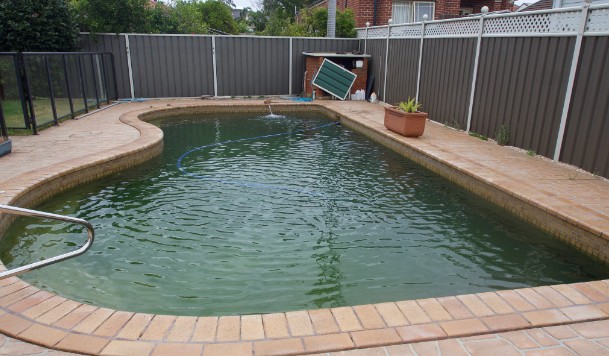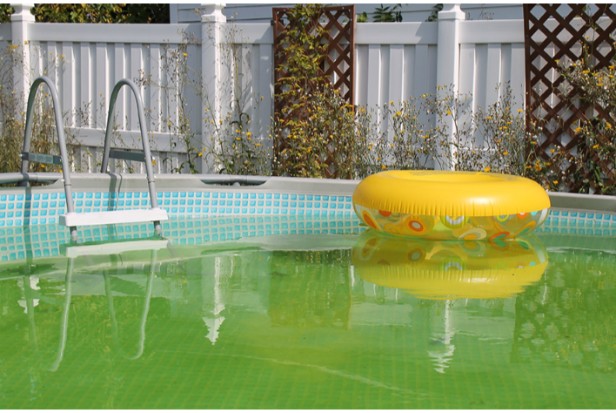Can You Swim in a Pool with Algae – Is It Safe?
In this article, I’ll go over why green algae is bad for swimming, what happens if you disregard the warnings, and how to get rid of the algae before swimming.
Due to the high bacterial concentration, you cannot swim in a pool that has algae. This bacteria can have a number of unpleasant side effects, including itching, rashes, nausea, and others. Additionally, algae blooms can stain your clothes and hair. Take a shower right away if you dive into an algae-filled pool.
There are actions you can take to protect your pool and those who swim in it, whether you’re already dealing with a swimming pool algae bloom or want to learn how to prevent it.
How Swimming Pool Algae Affects Pools
Untreated pool algae can harm your pool if you don’t take action. Algae can congregate and thicken, clogging your plumbing and filters. In the end, this results in the growth of more algae and may cause a serious obstruction. Additionally, it has the potential to seriously stain or lightly damage the surfaces of your equipment or pool. Black algae, in particular, has a propensity to grow deeply into surfaces in the swimming pool and stain them. Once it has fully taken hold, black algae is difficult to get rid of.
You must act quickly if you spot any indications of swimming pool algae. Otherwise, algae develop a resistance to common treatments like chlorine or chemical shocks. Once you have algae infestation under control, you’ll also want to put in place a regular testing and treatment schedule because algae infestation frequently results from a lack of maintenance.
How Swimming Pool Algae Affects Swimmers
Is pool algae dangerous if the water in your above-ground pool is green or otherwise discolored? In theory, it would be safe to swim in algae because they are not harmful on their own. Is swimming in a pool with algae safe, though? The response is “no.”‘
The cause is that swimming pool algae, especially when present in large quantities, is a haven for bacteria. For instance, the swimming pool’s mustard algae may be home to e. Coli. Additionally, the red algae in the pool is actually a type of bacteria that can cause illness in people, especially if it is not treated. Using an algae-filled pool can also result in rashes, eye infections, respiratory infections, diarrhea, and other health issues. Can you safely swim in a pool with algae before dismissing it?’, consider how much risk you’re willing to take with your health.
Common Types of Swimming Pool Algae
Swimming pool algae come in four different varieties, though green algae is the most well-known.
Black algae in a swimming pool looks like small black spots on the surfaces. The swimming pool’s black algae can quickly spread and deeply penetrate the surface once it gets into the cracks. In order to avoid damage, black algae in your swimming pool must be treated as soon as you notice it.
Green algae in a swimming pool is what most people picture when they think of algae. The water will turn slimy and green when green algae in the swimming pool spreads. Green algae can attach to the walls and floor of the swimming pool as it grows, and this algae will need to be scrubbed off.
Mustard algae in a swimming pool is named for its yellow color. In a pool, mustard algae are more likely to stick to surfaces or the areas around lights and ladder rungs than to float. The mustard algae in the pool are difficult to get rid of because they are resistant to chlorine.
Red algae in a swimming pool may look like algae but are actually bacteria. Red algae can become out of control and endanger swimmers if it isn’t treated in the pool. Red algae is carried by wind and rain into swimming pools, where it can become worse as a result of the sun’s rays mixing with sweat or chemicals.
It may seem impossible to manage pool algae on your own when you’re dealing with it. Visit our comprehensive guide to find out more about how to avoid or eliminate pool algae. Additionally, incorporate Pool Marvel Water Treatment into your maintenance schedule to improve the efficiency of chemical treatments and prevent the overgrowth of algae in swimming pools.

Is Green Algae in Pools Harmful to Swim In?
Because green algae in swimming pools contains dangerous bacteria, it is dangerous to swim in them. The spores on top of the water are so tiny that you can breathe them in. If it is not cleaned off of your clothing, green algae can get on there and cause irritation over time. Never swim in a pool that isn’t clear and clean.
Algae begin as tiny blooms. It’s most likely the beginning of a new bloom if your pool has a faint green tint. Additional indications of algae growth to watch for include cloudiness, brown spots, dark patches around the liner or gunite, etc. Small algae blooms can be brushed in order to direct them toward the skimmer basket and pool filter.
What Happens If You Swim in a Green Pool?
It’s possible to get a rash, sensitive skin, discomfort, and other things if you swim in a green pool. Green swimming pools keep a lot of harmful bacteria that is bad for you, your pets, and the water in the pool. Prior to swimming in the pool, always get rid of algae blooms.
Here’s what you should know about swimming in a green pool:
- Some green pools are discolored because there’s too much copper. Algae removal and prevention frequently involve copper. However, too much copper in the water can stain your pool, clothes, and hair. Additionally, it might make you scratch and damage the heater of your pool.
- Green lights and some chemicals can change the pool’s color. Your pool may not always be green because of algae. There probably won’t be enough algae in the pool to turn the water a discolored color if your chlorine level is around 4ppm. Don’t forget to circulate the chemicals for a few hours after thoroughly diluting them.
- Brushing green algae will turn the pool a light green shade. I always advise pool owners to brush the algae blooms because doing so makes it simpler to push them into the pool filter. Additionally, it aids in the removal of aquatic algae by chlorine and other algaecides. A vacuum can be used as well.
- Algae can be brown, pink, black, and yellow. Although green algae is the most frequent color in swimming pools, all algae colors should be handled carefully. Swimming is dangerous near algae. Before diving into the pool, clear the area of any algae and make sure to get rid of any cloudy or dead blooms.
Read on for a quick solution to remove algae if you’re concerned about swimming in a green pool or one with blooms of algae around the edges.
How Do You Clean Pool Algae for Swimming Safety?
To clean pool algae for swimming safety, follow these instructions:
- Turn on the pool pump and add chlorine shock. To avoid saturating the water, be careful not to add too much shock. For exact measurements, refer to the manufacturer’s instructions. To stop algae blooms and clean the water, pool shock spikes the chlorine immediately.
- Use an algaecide to prevent additional algae growth. As soon as the initial bloom of algae is eliminated, copper-based algaecides naturally stop it from growing again. You can also use algaecides, which gather small debris and deposit it at the bottom of the pool. To get rid of the algae, vacuum these clumps.
- Circulate the water until it looks white and cloudy. Pump circulation must be sufficient for all pool chemicals. While you are clearing the water, I advise running the pool pump continuously. If you don’t want to use a lot of electricity, you can stick with anything more than eight hours every day.
- Use a water clarifier. Your filter’s micron density will increase thanks to Robarb Super Blue Water Clarifier. More debris is gathered by this chemical than by sand, cartridges, or DE. To increase the pump’s gallons per minute after the water appears clear, clean the filter. A bottle can purify up to 160,000 gallons of water.
Maintaining the pool between 2ppm and 5ppm will greatly reduce the likelihood of algae blooms. To prevent algae growth in your pool, remember to maintain the alkalinity, pH, and phosphate levels. Optimal pump schedules also stop algae growth. Run your pump for an hour for every ten degrees warmer outside.
Is It Safe to Swim in a Pool With Dead Algae?
Because dead algae can harbor bacteria, swimming in a pool with it is not safe. Phosphates and nitrates are released by dead algae, which encourage algae growth. Before swimming in the pool, it’s crucial to remove the dead algae. Compared to vibrant green algae, dead algae typically appears white, cloudy, and dull.
Since dead algae is more difficult to spot, it can be just as dangerous as living algae. Most dead algae blooms appear gray, white, or cloudy. They seem unproblematic because they blend in with the background of the water.
I advise getting rid of any dead algae as soon as you can if you believe your swimming pool contains it. In a pool with live or dead algae, never swim. Utilizing water clarifiers to remove the dead algae and raising the chlorine level to stop it from regrowth.
Dead algae actually contains living bacteria, despite its name. Algal growth is increased by these bacteria. When getting rid of green algae blooms that are still alive, it is best to remove the dead algae at the same time.
FAQs
Is Brown Algae in Pool Dangerous
Whether mild or severe, it isn’t recommended. Numerous swimming pool algae encourage the growth of dangerous bacteria that consume algae. With a skin rash as the most frequent side effect, these bacteria put swimmers’ health at risk. Infections with different bacteria in the eyes or ears are also possible.
Is Pool Algae Harmful to Humans
Whether mild or severe, it isn’t recommended. Significant amounts of algae in swimming pools encourage the growth of dangerous bacteria that consume algae. Swimmers who are exposed to these bacteria run the risk of developing health problems, most frequently a skin rash. Various bacterial infections of the eyes or ears can also be brought on by it.
How to Get Rid of Algae in Pool Quickly
Any pool surfaces covered in algae, such as the walls, floors, and steps, should be scrubbed thoroughly using a pool brush. Follow the label’s instructions when using a green algaecide. After 24 hours, brush the pool surfaces once more. To get rid of any leftover dead algae, vacuum or backwash the area.
Is It Safe to Swim in Pool With Dead Algae
Whether mild or severe, it isn’t recommended. Large amounts of algae in swimming pools encourage the growth of dangerous bacteria that consume algae. Swimmers who are exposed to these bacteria run the risk of developing health problems, most frequently a skin rash. Additionally, it can result in different bacterial infections of the eyes or ears.
Is It Safe to Swim in a Pool With Green Algae
Whether mild or severe, it isn’t recommended. Pools with a lot of algae provide a favorable environment for the growth of dangerous bacteria that consume algae. Swimmers who are exposed to these bacteria run the risk of developing health problems, most frequently a skin rash. Infections with different bacteria in the eyes or ears are also possible.
